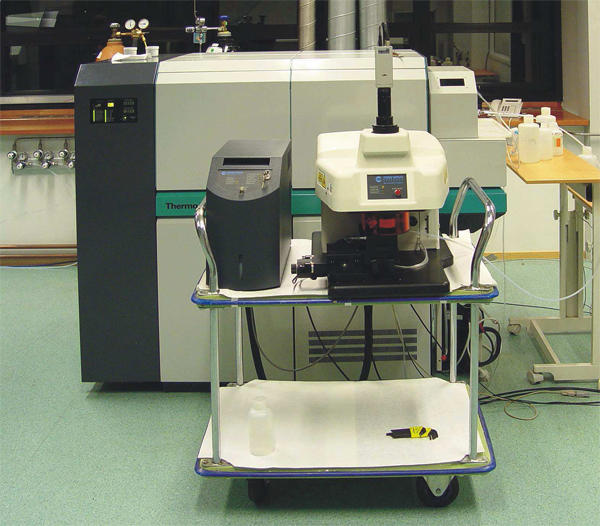Bergen Geoanalytical Facility
The Bergen Geoanalytical Facility - BGF (formerly CEIA) was established around several existing geoanalytical techniques at the University of Bergen and it was officially opened on 29th September 2005.

Hovedinnhold
Article by Professor Jan Kosler and taken from Geoviten-ekstern
The facility is hosted by Department of Earth Science and operated jointly by the Department and Centre for Geobiology. The main goal of BGF is to serve fundamental and applied research in elemental and isotope geochemistry and analytical chemistry for scientists from academic and government institutions, private companies and industry. The initial funding of BGF was from the University of Bergen and the Norwegian Research Council; subsequently it also received support from various collaborative projects both within and outside the University. The major users of the BGF facility at UiB include Department of Earth Science, Centre for Geobiology, Bjerknes Centre for Paleoclimate Research, Department of Biology, Department of Clinical Dentistry and Haukeland University Hospital. The main expertise of the BGF is in phase, elemental and isotopic analysis of inorganic samples (geological, archaeological, biological and environmental) but we also do analyses of various organic matrices like blood serum, shells or organic-rich sediments.
Today the Bergen Geoanalytical Facility consists of seven laboratories that host a range of instruments from small table-top chromatographs to large scale Xray instruments and mass spectrometers. Laboratory for plasma source (or ICP) spectrometry makes use of optical emission ICP instrument that is primarily used for major and minor element concentration measurements in water samples, single collector ICP mass spectrometer that is almost exclusively used for trace element analysis and U-Pb dating of accessory minerals and a multiple collector ICP mass spectrometer that is utilized for precise isotope ratio measurements of number of elements, including Li, Fe, Hf, Nd and Pb.
All ICP spectrometers normally analyze samples in solution but we can also couple them to one of our UV laser ablation systems that allow us to make direct microanalysis of solid samples, such as are mineral grains, fish otoliths or human teeth. This is of great importance for many projects in Earth science because the studied objects are often on submillimeter scale and need to be analyzed in-situ. The use of ICP laboratory is truly multidisciplinary. Laboratory for thermal ionization mass spectrometry (TIMS) is primarily used for precise isotope ratio measurements of Sr and Nd in geological, archaeological and environmental samples and it is located next to the clean laboratory where we prepare all samples for TIMS and ICP spectrometry measurements.
The last issue of Geoviten featured the laboratory for Raman spectrometry, the latest addition to the family of BGF techniques. It will be mainly utilized by scientists from the Centre for Geobiology for rapid identification of mineral phases, fluid inclusions, biologic compounds, and products of biomineralization. Also new is our laboratory for geobiology where we do mainly water analysis using specialized elemental analyzers and Single collector ICP-MS instrument with UV solid state laser ablation system in BGF laboratories UV laser ablation system liquid chromatographs. It is in this laboratory where water and biological samples collected during yearly scientific cruises to the North Atlantic get first analyzed. While the X-ray techniques have been used in mineralogy since 1920s, they are still of great importance in Earth sciences. The Laboratory for X-ray analysis hosts a 1989 vintage X-ray fluorescence spectrometer that is used for major and trace element analysis of rocks and soils. It is a rapid and inexpensive technique widely used by many geologists. We have recently decommissioned our old X-ray diffractometer and established a new collaboration with Department of Chemistry at UiB that has a modern X-ray diffraction facility.
Major and trace element analysis of large samples, such as sediment cores collected from the ocean floor are now routinely analyzed in the core scanner laboratory. In addition, we also make use of many facilities for sample preparation and elemental analysis (sample homogenization, mineral separation, thin section preparation and laboratory for electron microscopy) in the Department of Earth Science and UiB.
Bergen Geoanalytical Facility could not exist without the effort of people who work in the laboratories. Master and doctoral students, research and academic staff are supported by five technicians and engineers who make sure that the analytical instruments and laboratories are functional and contribute to the flawless operation of the facility.
Over the time of its existence, the BGF has established collaboration with more than 40 universities, research institutes and industrial companies worldwide and collaborates with similar laboratory centres in 21 countries. We are active in development and implementation of new analytical techniques, tests of interlaboratory comparisons and development of new reference materials.
In 2008 we co-organized the 9th European Workshop on Laser Ablation in Prague. We have been involved in scientific projects on all 6 continents, several places of the ocean floor and we also worked on Lunar samples. Our activities resulted in numerous publications, student theses and new research and industrial projects. We plan to continue in these activities also in the years to come. Take a tour through the labs on our web site at http://www.geo.uib.no/bgf and see what we do at BGF.
